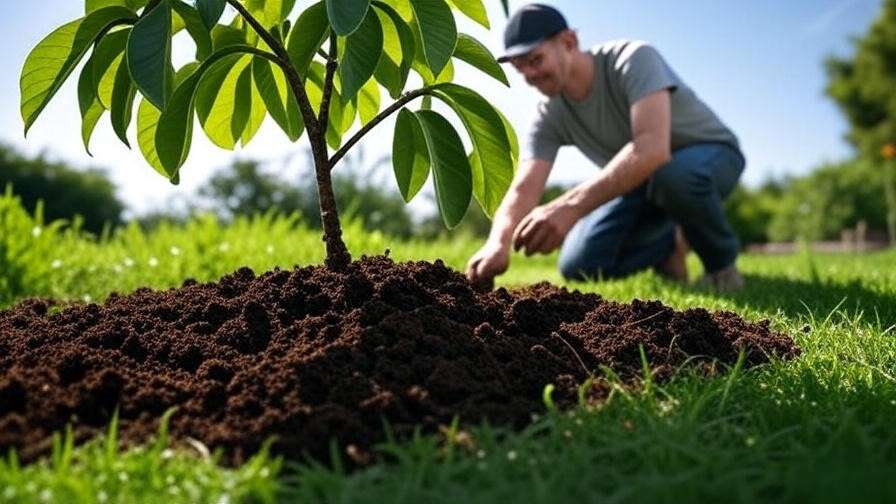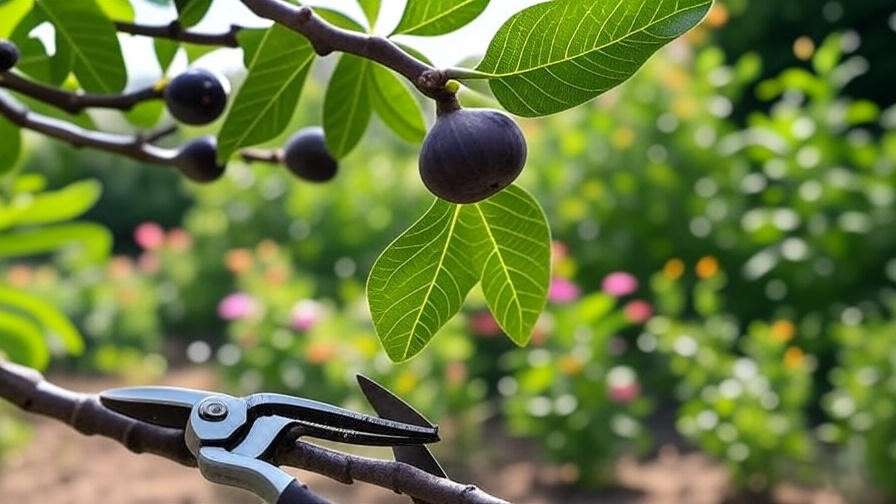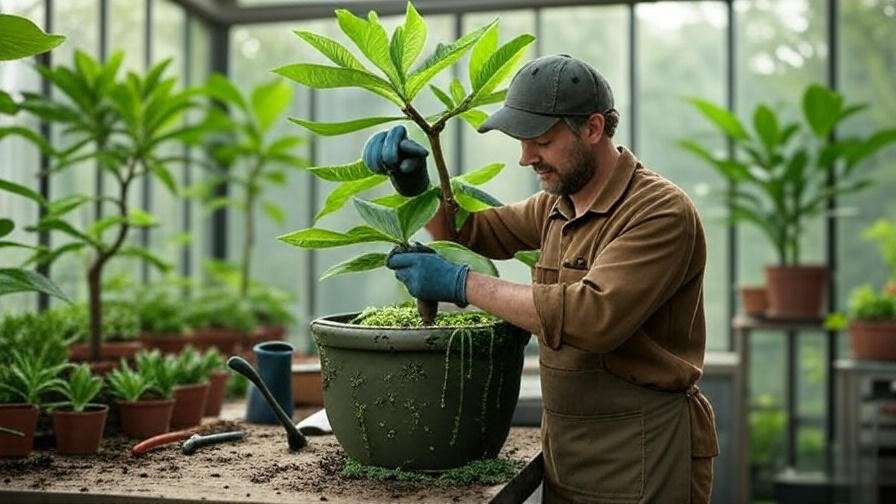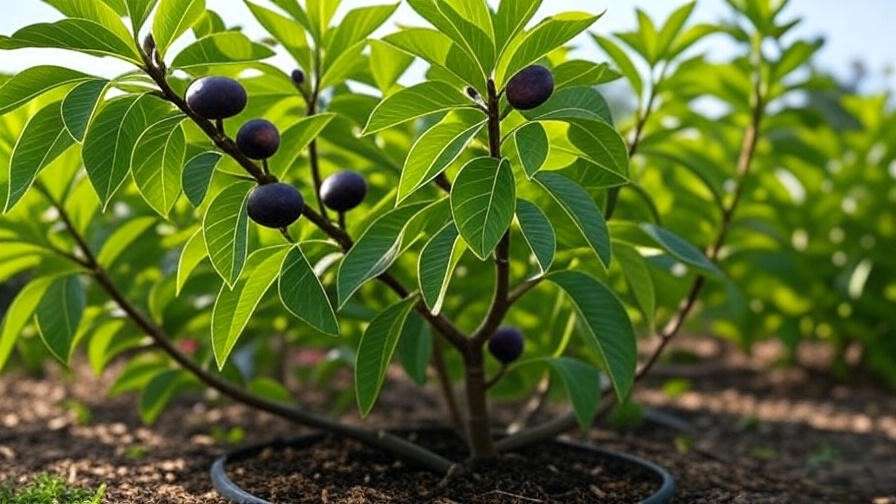Imagine biting into a sweet, juicy Black Mission Fig Tree fruit, freshly picked from your own backyard. This versatile and resilient tree not only produces delectable figs but also adds stunning ornamental beauty to any garden. Whether you’re a novice gardener or a seasoned horticulturist, growing a Black Mission Fig Tree is a rewarding journey that yields abundant harvests with the right care. In this comprehensive guide, we’ll walk you through every step to ensure your fig tree thrives, from planting to harvesting. Get ready to cultivate a flourishing Black Mission Fig Tree that becomes the centerpiece of your garden! 🌳
The Black Mission Fig Tree, known for its dark purple-black skin and sweet, pinkish flesh, is a favorite among home gardeners for its high yield and adaptability. Native to the Mediterranean and popularized in California, this variety is perfect for warm climates but can also thrive in containers in cooler regions. In this article, we’ll share expert-backed tips to address common challenges, maximize fruit production, and keep your tree healthy for years to come. Let’s dive into the essentials of Black Mission Fig Tree care! 🌿
1. Understanding the Black Mission Fig Tree 🌿
1.1 What Makes the Black Mission Fig Unique? 🍇
The Black Mission Fig Tree (Ficus carica ‘Black Mission’) is a standout variety with a rich history. Introduced to California by Spanish missionaries in the 18th century, it’s named after the missions where it was first cultivated. Its figs are prized for their deep purple-black skin, sweet and juicy pinkish-red flesh, and a flavor that balances sweetness with a hint of berry-like tartness. These trees typically grow to 10-20 feet tall and wide, making them suitable for both spacious yards and compact gardens when pruned or grown in containers.
What sets the Black Mission apart is its prolific fruiting and resilience. It produces two crops annually in ideal conditions: a smaller breba crop in early summer and a main crop in late summer to fall. Its disease resistance and low maintenance needs make it a top choice for home gardeners. Whether you’re growing it for fresh figs, preserves, or ornamental appeal, this tree delivers. 🌸
1.2 Ideal Growing Zones and Climate Needs ☀️
Black Mission Fig Trees thrive in USDA Hardiness Zones 7-10, where temperatures rarely dip below 10°F (-12°C). They love warm, sunny climates, requiring at least 6-8 hours of direct sunlight daily to produce abundant fruit. While they’re drought-tolerant once established, consistent moisture is key during their early years.
For gardeners in colder regions (Zones 5-6), growing a Black Mission Fig Tree in a container is a smart solution. Containers allow you to move the tree indoors during winter, protecting it from frost. Ensure good drainage, as figs dislike waterlogged roots. If you’re in a borderline zone, consider planting near a south-facing wall to trap heat and extend the growing season. 🌞
2. Planting Your Black Mission Fig Tree 🌱
2.1 Choosing the Perfect Location 📍
Selecting the right spot is critical for your Black Mission Fig Tree’s success. Aim for a location with full sun exposure—6-8 hours of direct sunlight daily—to boost fruit production and overall health. The soil should be well-draining and loamy, with a pH between 6.0 and 6.5. Test your soil with a pH kit (available at garden centers) to ensure it’s in the ideal range; amend with lime to raise pH or sulfur to lower it if needed.
Space is another consideration. A mature Black Mission Fig Tree can spread 15-20 feet, so plant it at least 10-15 feet from structures or other trees to avoid competition. If space is limited, dwarf varieties or container planting are excellent options. Avoid low-lying areas where cold air collects, as this can increase frost risk. 🏡
2.2 Step-by-Step Planting Guide 🌳
Planting your Black Mission Fig Tree correctly sets the stage for healthy growth. Follow these steps for success:
- Timing: Plant in early spring or late fall when the tree is dormant. This minimizes transplant shock and allows roots to establish before hot or cold extremes.
- Prepare the Soil: Dig a hole twice as wide and as deep as the root ball. Mix native soil with 20-30% compost or aged manure to improve fertility and drainage.
- Planting: Place the tree in the hole, ensuring the top of the root ball is level with the soil surface. Backfill with soil, tamping gently to remove air pockets.
- Watering: Water deeply after planting to settle the soil. Add a 2-3 inch layer of mulch (e.g., wood chips or straw) around the base, keeping it 2 inches from the trunk to prevent rot.
- Staking: If your tree is tall or in a windy area, use a stake to support it for the first year.
Expert Tip: Avoid planting too deeply, as this can suffocate roots and stunt growth. Check that the trunk’s flare (where roots begin) remains above ground. 🌲

3. Caring for Your Black Mission Fig Tree 🌿
3.1 Watering Requirements 💧
Proper watering is essential for a healthy Black Mission Fig Tree. Young trees need consistent moisture to establish roots—water deeply (about 1-2 inches) once or twice weekly, depending on rainfall and soil drainage. Mature trees are more drought-tolerant but still benefit from deep watering every 7-10 days during dry spells, especially when fruiting.
Check soil moisture by digging 2-3 inches down; water if it feels dry. Overwatering can lead to root rot, so ensure proper drainage. Signs of overwatering include yellowing leaves or mushy roots, while underwatered trees may drop fruit or have wilted leaves. Adjust based on your climate—less frequent in humid areas, more in arid ones. 💦
3.2 Fertilizing for Healthy Growth 🌾
Fertilizing your Black Mission Fig Tree supports vigorous growth and fruit production. Use a balanced fertilizer (e.g., 10-10-10 or 8-8-8) or an organic alternative like composted manure. Apply in early spring as new growth begins, and again in early summer for fruiting trees. For a 2-3 year-old tree, use 1-2 pounds of fertilizer, increasing to 3-5 pounds for mature trees.
Spread fertilizer evenly around the drip line (the area under the outer edge of the canopy), then water thoroughly. Avoid over-fertilizing, as excess nitrogen can lead to lush foliage at the expense of fruit. Test soil annually to monitor nutrient levels and adjust as needed.
Expert Insight: For optimal fruiting, ensure a balance of nitrogen (for growth), phosphorus (for roots and fruit), and potassium (for overall health). A soil test from your local extension service can pinpoint deficiencies. 🌿
3.3 Pruning for Shape and Productivity ✂️
Pruning is key to maintaining a productive and healthy Black Mission Fig Tree. It encourages fruit production, improves air circulation, and keeps the tree manageable. Prune in late winter or early spring when the tree is dormant, using clean, sharp shears.
Pruning Steps:
- Remove Dead or Damaged Wood: Cut away any broken, diseased, or dead branches to prevent pest and disease spread.
- Shape the Tree: Maintain an open, vase-like structure with 3-5 main branches to allow sunlight and air to reach the center.
- Thin Crowded Areas: Remove crossing or inward-growing branches to reduce competition.
- Control Height: Trim back overly long branches to keep the tree at a manageable size (8-12 feet for easy harvesting).
Common Mistake: Avoid heavy pruning in summer, as it can stress the tree and reduce fruit yield. Instead, do light maintenance pruning if needed. 🌳

4. Protecting Your Black Mission Fig Tree from Pests and Diseases 🐞
4.1 Common Pests to Watch For 🕷️
While Black Mission Fig Trees are relatively pest-resistant, a few critters can pose problems. Common pests include:
- Fig Beetles: These shiny green beetles feed on ripe fruit. Control them by picking figs promptly and using traps or netting.
- Spider Mites: Tiny pests that cause stippling on leaves. Spray with neem oil or insecticidal soap, focusing on leaf undersides.
- Scale Insects: Small, immobile pests that suck sap. Remove with a soft brush or apply horticultural oil.
Organic Control: Encourage natural predators like ladybugs and lacewings by planting companion plants like marigolds or dill. Regularly inspect your tree for early signs of infestation, especially during hot, dry weather. 🐝
4.2 Diseases and How to Prevent Them 🦠
Black Mission Fig Trees are prone to a few diseases, but proper care minimizes risks:
- Root Rot: Caused by overwatering or poor drainage. Ensure well-draining soil and avoid waterlogging.
- Leaf Spot: Fungal spots on leaves, often due to wet foliage. Improve air circulation through pruning and water at the base, not overhead.
- Rust: Orange-brown spots on leaves. Apply a copper-based fungicide and remove affected leaves.
Preventative Measures: Sanitize tools between cuts, remove fallen leaves, and maintain tree vigor through proper watering and fertilizing. Early detection is key—check leaves and roots regularly.
Expert Tip: If you suspect disease, consult your local cooperative extension service for a diagnosis and tailored treatment plan. 🌱
5. Harvesting and Enjoying Your Black Mission Figs 🍈
5.1 When and How to Harvest 🧺
One of the most rewarding moments of growing a Black Mission Fig Tree is harvesting its sweet, juicy figs. Knowing when and how to pick them ensures the best flavor and protects your tree. Black Mission Figs are typically ready to harvest in late summer to early fall for the main crop, with a smaller breba crop in early summer in some regions.
Signs of Ripeness:
- Color: Figs turn a deep purple-black, almost glossy, when fully ripe.
- Texture: Ripe figs feel soft but not mushy when gently squeezed.
- Position: Figs may droop slightly on their stems, indicating they’re ready.
Harvesting Technique:
- Wear gloves to avoid skin irritation from fig sap, which can be mildly irritating.
- Gently twist the fig or use pruning shears to cut it from the stem, leaving a small portion of the stem attached to the fruit.
- Handle figs carefully to avoid bruising, as they’re delicate when ripe.
Storage Tips: Fresh figs are perishable and best eaten within a few days. Store them in a single layer in the refrigerator for up to a week. For longer storage, consider drying, freezing, or making preserves. Place figs in a breathable container, like a paper bag, to prevent moisture buildup.
Expert Tip: Harvest in the morning when temperatures are cooler to preserve flavor and firmness. Avoid picking unripe figs, as they won’t ripen further off the tree. 🍇
5.2 Creative Ways to Use Your Figs in the Kitchen 🍽️
Black Mission Figs are incredibly versatile, adding a sweet, earthy flavor to both sweet and savory dishes. Here are a few ideas to enjoy your harvest:
- Fresh: Eat them straight from the tree or pair with cheese and nuts for a simple snack.
- Fig Jam: Simmer figs with sugar, lemon juice, and a pinch of cinnamon for a delicious spread.
- Salads: Add halved figs to arugula with goat cheese, walnuts, and balsamic vinaigrette.
- Desserts: Bake a Black Mission Fig and Goat Cheese Tart (recipe below).
- Savory Dishes: Roast figs with pork or chicken for a sweet-savory balance.
Nutritional Benefits: Figs are packed with fiber, vitamins A, B, and C, and minerals like potassium and magnesium. They’re also rich in antioxidants, supporting heart health and digestion.
Sample Recipe: Black Mission Fig and Goat Cheese Tart
- Ingredients: 1 puff pastry sheet, 8-10 fresh Black Mission Figs (halved), 4 oz goat cheese, 2 tbsp honey, 1 tsp fresh thyme, 1 egg (for egg wash).
- Instructions:
- Preheat oven to 400°F (200°C).
- Roll out puff pastry on a baking sheet and score a 1-inch border.
- Spread goat cheese within the border, arrange fig halves on top, and drizzle with honey.
- Sprinkle thyme, brush border with egg wash, and bake for 20-25 minutes until golden.
- Serve warm or at room temperature.
This tart is a crowd-pleaser, perfect for garden gatherings! 🌟
6. Advanced Tips for Maximizing Your Fig Tree’s Potential 🌟
6.1 Container Gardening for Small Spaces 🪴
If you lack space or live in a colder climate, growing a Black Mission Fig Tree in a container is a fantastic option. Containers allow flexibility to move the tree indoors during winter and fit small patios or balconies.
Choosing a Container:
- Select a pot at least 15-20 gallons with drainage holes to prevent root rot.
- Use a well-draining potting mix, such as a blend of potting soil, perlite, and compost.
Care Adjustments:
- Water more frequently than in-ground trees, as containers dry out faster. Check soil daily and water when the top inch feels dry.
- Fertilize monthly during the growing season with a liquid balanced fertilizer (e.g., 10-10-10).
- Prune to maintain a compact shape, focusing on removing leggy growth.
Winter Care: In colder zones, move the container to a garage or indoors near a sunny window when temperatures drop below 10°F (-12°C). Reduce watering during dormancy but don’t let the soil dry out completely.
Success Tip: Repot every 2-3 years to refresh soil and prevent root-bound conditions. 🌱

6.2 Propagating Your Black Mission Fig Tree 🌱
Propagating your Black Mission Fig Tree allows you to expand your garden or share with others. The most common method is taking cuttings, which is straightforward with the right approach.
Step-by-Step Guide to Cuttings:
- Timing: Take 6-8 inch cuttings from healthy, one-year-old wood in late winter or early spring.
- Preparation: Cut just below a node, remove lower leaves, and dip the cut end in rooting hormone (optional but helpful).
- Planting: Place cuttings in a pot with a mix of sand and potting soil, keeping it moist but not soggy.
- Environment: Keep in a warm, humid location with indirect light. A plastic bag over the pot can create a greenhouse effect.
- Rooting: Roots typically form in 4-6 weeks. Transplant to a larger pot or the ground once roots are established.
Expert Insight: Patience is key—some cuttings take longer to root. Check for resistance when gently tugging to confirm root growth. 🌿

6.3 Winter Care for Long-Term Health ❄️
Protecting your Black Mission Fig Tree during winter ensures it thrives for decades (these trees can live 50+ years!). In Zones 7-10, mild winters require minimal effort, but colder areas need extra care.
Winter Protection:
- Mulching: Apply a 3-4 inch layer of organic mulch (e.g., straw or bark) around the base to insulate roots.
- Wrapping: In borderline zones, wrap the trunk with burlap or frost cloth to shield from freezing winds.
- Covering: For young trees, use a frost blanket or build a temporary frame with burlap to protect branches.
Dormancy Care:
- Reduce watering to once every 2-3 weeks, as the tree’s water needs decrease.
- Avoid fertilizing during dormancy to prevent stress.
Expert Tip: If heavy snow is expected, gently shake branches to prevent breakage. For container trees, ensure they’re in a sheltered spot to avoid root freeze. ❄️

7. Troubleshooting Common Black Mission Fig Tree Problems 🔧
Even with the best care, issues can arise. Here’s a guide to common problems, their causes, and solutions:
| Issue | Symptoms | Causes | Solutions |
|---|---|---|---|
| Yellowing Leaves | Leaves turn yellow and drop | Overwatering, nutrient deficiency, or poor drainage | Check soil drainage, reduce watering, and test soil for nutrient imbalances. Apply balanced fertilizer if needed. |
| Dropping Fruit | Unripe figs fall prematurely | Water stress, nutrient imbalance, or pest damage | Ensure consistent watering, fertilize appropriately, and inspect for pests like fig beetles. |
| Stunted Growth | Slow growth, small leaves | Poor soil, root-bound (in containers), or insufficient sunlight | Amend soil with compost, repot container trees, or relocate to a sunnier spot. |
When to Seek Help: If problems persist despite corrections, contact your local cooperative extension service or a certified arborist for a professional diagnosis. They can provide tailored advice based on your region’s climate and soil conditions. 🌳
8. FAQs About Black Mission Fig Tree Care ❓
- How fast does a Black Mission Fig Tree grow?
Black Mission Fig Trees grow moderately, reaching 10-20 feet in 5-7 years with proper care. Growth is faster in ideal conditions (full sun, fertile soil). - Can I grow a Black Mission Fig Tree in a pot?
Yes! Use a large container (15-20 gallons) with well-draining soil and bring indoors in winter for colder climates. - Why isn’t my fig tree producing fruit?
Common reasons include insufficient sunlight, over-fertilizing with nitrogen, or young tree age (most fruit after 2-3 years). Ensure 6-8 hours of sun and balanced fertilization. - How do I protect my tree from birds and squirrels?
Use bird netting or reflective tape to deter animals. Harvest figs promptly to reduce attraction. - What’s the lifespan of a Black Mission Fig Tree?
With proper care, these trees can live 50-100 years, producing fruit for decades.
Conclusion: Your Path to a Thriving Black Mission Fig Tree 🌳
Growing a Black Mission Fig Tree is a delightful and achievable endeavor for gardeners of all skill levels. By choosing the right location, planting correctly, and providing consistent care—watering, fertilizing, pruning, and pest control—you’ll enjoy abundant harvests of sweet, juicy figs. Whether you’re savoring them fresh, baking them into tarts, or sharing with friends, your fig tree will be a source of pride and joy.
Start your Black Mission Fig Tree journey today! Join our gardening community by sharing your progress, tips, or questions in the comments below. For more resources, check out trusted sites like the University of California’s Agriculture and Natural Resources (ucanr.edu) or your local nursery for region-specific advice. Happy gardening! 🌿













